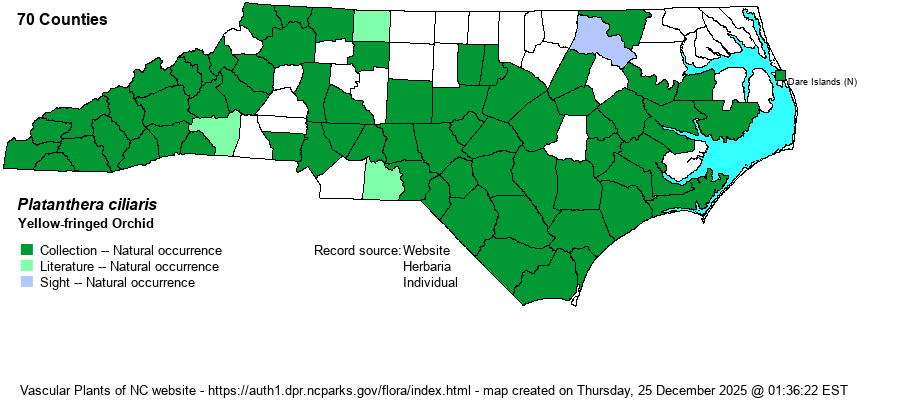| Author | (L.) Lindley | |
| Distribution | Roughly occurs statewide, though is essentially absent from the northeastern Coastal Plain. Also scarce in the extreme northern Piedmont. It possibly could occur in all Mountain counties.
A very wide range for a Platanthera, occurring north to MA, southern ON, and northern IL, and then south to the Gulf Coast from FL to eastern TX. The BONAP map shows occurrences for nearly all southeastern VA counties, so its "absence" from adjacent NC makes no sense, though certainly cannot be an artifact of collecting (as this is a conspicuous species). | |
| Abundance | Uncommon to locally fairly common in the southern half of the Coastal Plain, including the Sandhills. Uncommon but widespread in the Mountains. Elsewhere -- Piedmont and northern parts of the Coastal Plain -- generally rare. Individual populations vary from a few plants to many dozen. | |
| Habitat | In the Coastal Plain, it is found mainly in savannas, streamhead ecotones, and less so in wet flatwoods and other damp but sunny places. In the Mountains, it is found in a variety of meadows and other "grassy" places, including bogs. It also occurs in drier habitats, such as roadbanks, upland grasslands, and grassy powerline clearings. It is one of the most widely ranging orchids in the state, in terms of habitat variety. | |
| Phenology | Bloom in mid-summer, typically from late July to late August. It fruits shortly after blooming. | |
| Identification | This is one of three orange to golden-yellow fringed orchids in the state; as there are few truly orange wildflowers in the state, it should be easily identified. This striking species grows to 1.5-2 feet tall on average, with the conical inflorescence containing several dozen large flowers; the flower cluster is about 4-6 inches tall. It has the strongly fringed lip and long, narrow spur that several other fringed orchids have. The lip, about 3/4-inch long, is much longer than the 1/4-inch long lips of the other two golden-orange species -- P. cristata and P. integra. The last of these has no fringes at all on the lip, whereas P. cristata has a much smaller and denser flower cluster, usually less than 3 inches tall. All Platanthera species tend to have several long, narrow, ascending leaves growing on the lower part of the stem. Basically, this is an identical version of P. conspicua, except that that species has white flowers and P. ciliaris has soft orange flowers. Note that occasional hybrids between this and the two White-fringed Orchids are produced; they have creamy yellow flowers. | |
| Taxonomic Comments | None, other than it and nearly all other Platanthera species were formerly in the genus Habenaria.
| |
| Other Common Name(s) | Though the flower color is usually orange, the common name is almost universally Yellow Fringed Orchid. Some references do use the more appropriate Orange Fringed Orchid. | |
| State Rank | S4 | |
| Global Rank | G5 | |
| State Status | | |
| US Status | | |
| USACE-agcp | FACW link |
| USACE-emp | FACW link |

